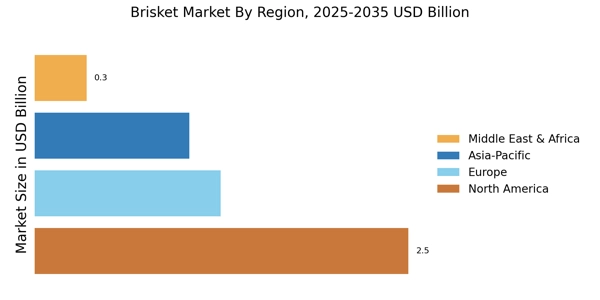Health Consciousness and Lean Meat Trends
In recent years, there has been a marked shift in consumer preferences towards healthier eating habits, which has implications for the brisket market. As consumers become more health-conscious, they are increasingly seeking leaner cuts of meat, which has led to a rise in demand for brisket that is perceived as a healthier option when prepared correctly. Data suggests that the demand for leaner beef cuts has grown by approximately 15%, reflecting a broader trend towards healthier protein sources. This shift is prompting producers to adapt their offerings, focusing on grass-fed and organic brisket options that align with health trends. Consequently, the brisket market is likely to see a diversification of products that cater to health-conscious consumers, potentially expanding its customer base and enhancing market growth.
Culinary Innovation and Recipe Development
The brisket market is being influenced by culinary innovation and the development of new recipes that highlight brisket as a versatile ingredient. Chefs and home cooks alike are experimenting with various cooking techniques and flavor profiles, which has led to an increased interest in brisket dishes. Recent surveys indicate that over 30% of consumers are actively seeking new recipes that incorporate brisket, suggesting a growing curiosity about this cut of meat. This trend is not only enhancing the visibility of brisket in culinary circles but also driving demand for diverse brisket products. As more consumers explore brisket in different cuisines, the market is likely to expand, offering opportunities for producers to innovate and cater to evolving tastes within the brisket market.
Growing Popularity of Barbecue Restaurants
The brisket market is experiencing a notable surge in the popularity of barbecue restaurants. This trend is driven by a growing consumer preference for dining experiences that emphasize smoked and grilled meats. According to recent data, the number of barbecue restaurants has increased by approximately 10% over the past year, indicating a robust demand for brisket as a menu staple. As these establishments proliferate, they contribute significantly to the overall consumption of brisket, thereby enhancing its market presence. Furthermore, the rise of food festivals and competitions centered around barbecue has further solidified brisket's status as a favored choice among meat enthusiasts. This growing interest in barbecue culture not only boosts sales for restaurants but also stimulates demand for high-quality brisket cuts from suppliers, thereby impacting the brisket market positively.
E-commerce and Online Meat Delivery Services
The brisket market is witnessing a transformation due to the rise of e-commerce and online meat delivery services. As consumers increasingly turn to online platforms for their grocery needs, the demand for high-quality brisket available for home delivery is on the rise. Recent statistics indicate that online meat sales have surged by over 20% in the past year, reflecting a significant shift in purchasing behavior. This trend is particularly appealing to younger consumers who prioritize convenience and quality. E-commerce platforms are now offering a variety of brisket cuts, often sourced from local farms, which enhances the appeal of purchasing meat online. As this trend continues, it is likely to reshape the brisket market, providing new opportunities for suppliers and retailers to reach a broader audience.
Rising Interest in Home Cooking and Grilling
The brisket market is benefiting from a rising interest in home cooking and grilling, as more consumers are choosing to prepare meals at home. This trend has been fueled by a desire for quality ingredients and the enjoyment of cooking as a leisure activity. Data shows that sales of grilling equipment and accessories have increased by approximately 25%, indicating a strong inclination towards outdoor cooking. As consumers invest in their home cooking experiences, brisket has emerged as a favored choice for grilling and smoking, further driving its demand. This shift towards home-based culinary experiences is likely to sustain growth in the brisket market, as consumers seek to replicate restaurant-quality meals in their own kitchens.


















Leave a Comment